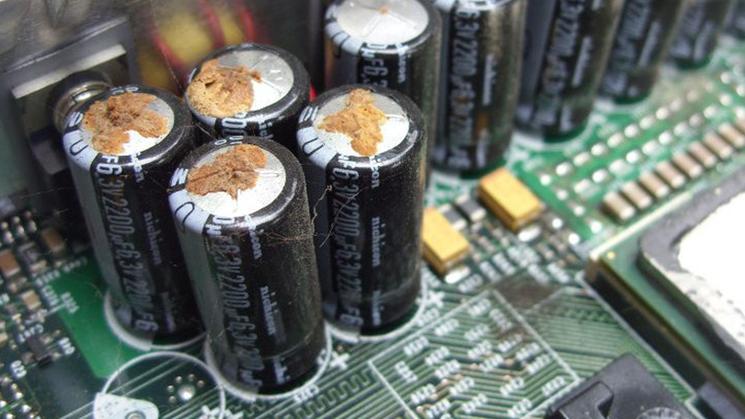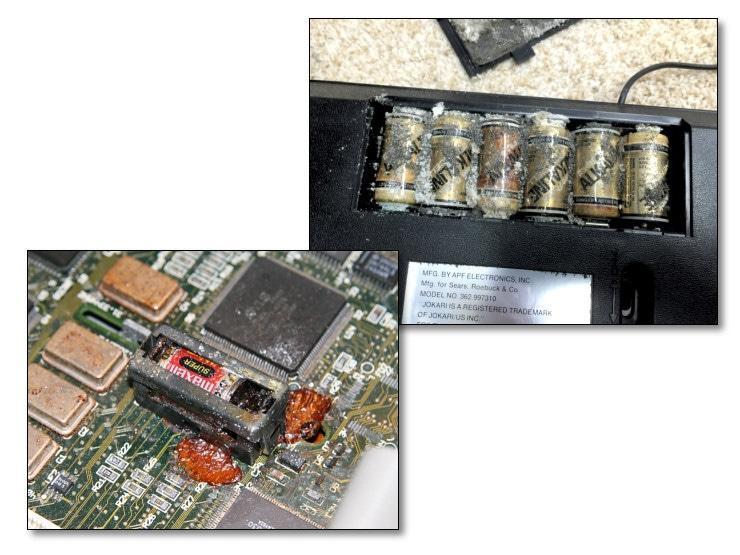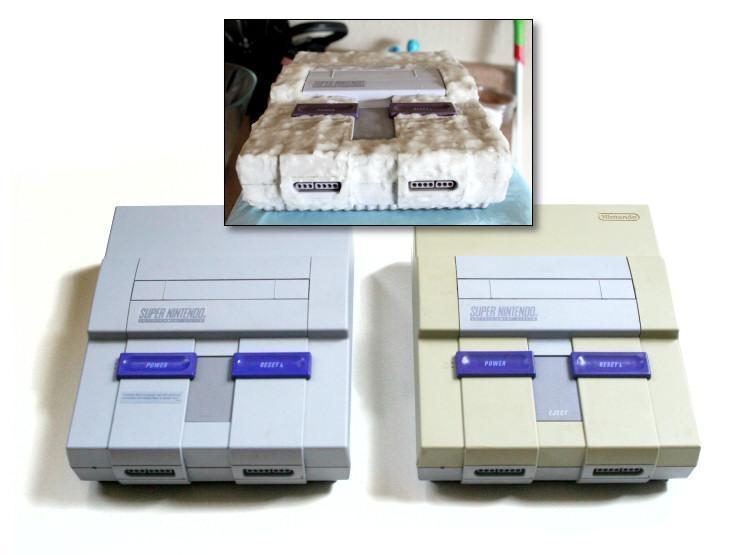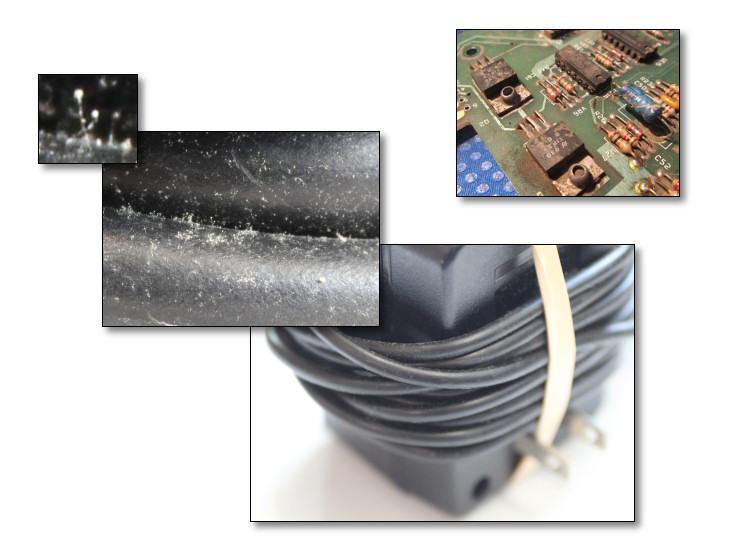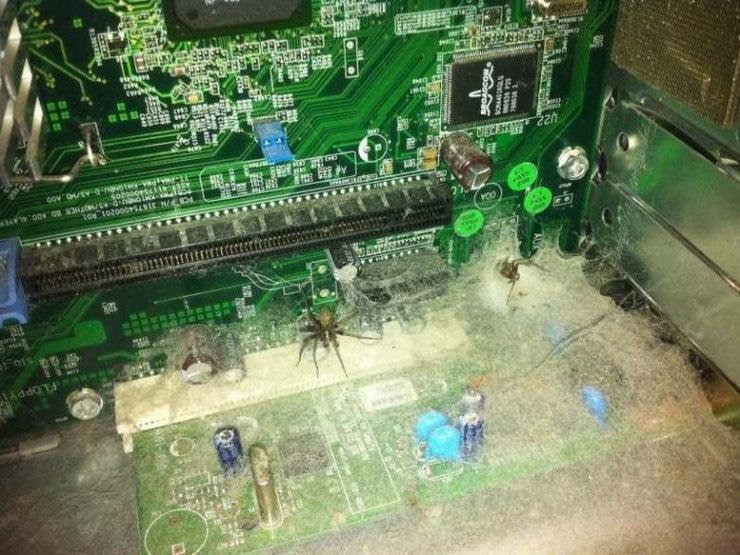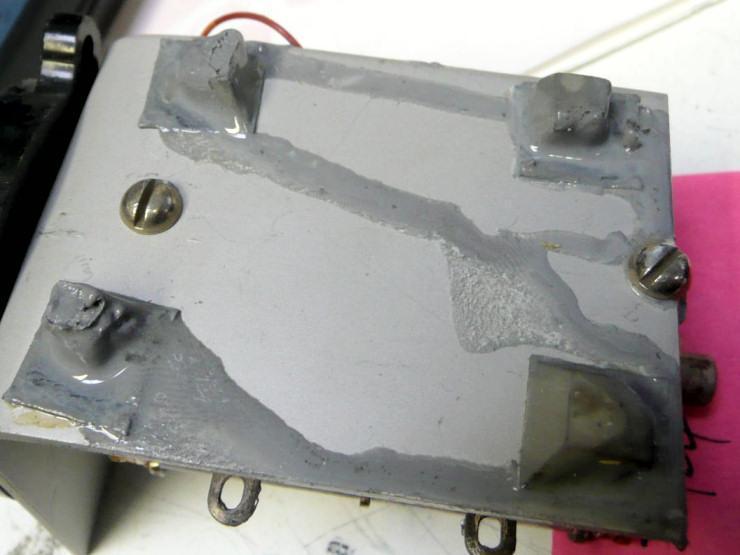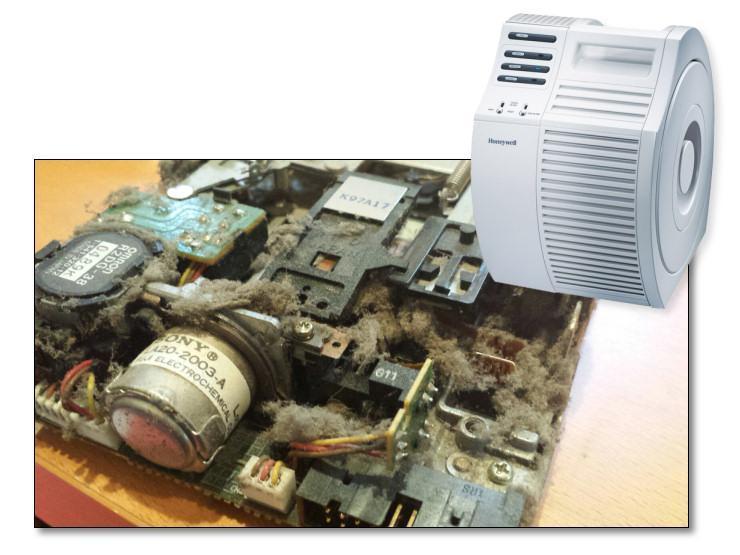|
Decay and decomposition are part of nature. Weather, bugs, fungus, and microorganisms take their toll, chemical bonds break apart, and physical damage (drops, falls, cave-ins) can occur. Let's just call it entropy. As living things, we are always fighting against a state of disorder in the universe, and that goes for everything we create as well. If you follow these tips, you'll already be a step ahead of entropy as it tries to break down and destroy your prized electronic devices. We may never be able to halt the decay process entirely, but we can at least slow it down so that future generations can have a better understanding of the gadgets that shaped the world we live in. Remove Batteries of Every Kind Alkaline batteries (upper-right photo) are the bane of every gadget collector. That's because they almost always leak a caustic substance, potassium hydroxide, when they completely discharge. It can happen even if a device is turned off, so if you're not using a toy or gadget for longer than a week, make sure you remove the batteries. Otherwise, the potassium hydroxide will cause corrosion and serious damage to their surrounding circuitry. It can also eat its way up a wire and into a completely different area of a circuit board. Many devices with battery-backed RAM (to save settings, etc.) or internal clocks use small internal batteries (usually lithium), and sometimes they come soldered to the PC board. While lithium batteries do not leak as often as alkalines, they still represent a ticking chemical time bomb. Remove, clip off, or desolder those embedded batteries before they leak and destroy the surrounding circuitry. The same thing goes for vintage laptops and portable computers, which typically used rechargable NiCd cells. Remove battery packs and isolate them in plastic bags before they inevitably leak. If necessary, safe the plastic battery pack casing so you can rebuild it with fresh cells in the future. Mind the Plastics and Avoid UV Light Plastics are physically durable in the short term, which has given them a reputation of being nearly indestructible. But the enemy of plastic durability lies within—most plastics are actually volatile compounds in a state of slow chemical breakdown. Different ratios of fire retardants, colorants, or hardeners added during the manufacturing process can accelerate or hinder this process. As with the case of the Super NES seen here, a sure sign of plastic breakdown is discoloration. Plastics often discolor when exposed to UV light—or merely oxidation—over time. Both UV and oxygen drastically accelerate the chemical breakdown process. Strong sources of UV include fluorescent light bulbs and the sun, so keep your prized gadgets in the dark and away from windows. Meanwhile, older discolored plastics can become brittle and pose a breaking hazard, so handle them gingerly. Early 1990's Macintosh computer cases in particular like to both discolor and break apart. One potential remedy for discoloration is called Retrobright (see inset photo with solution applied), but prevention is just as important. In the long term, our reliance on plastic goods represents a preservation nightmare that will surely haunt archivists for generations to come. Remove or Replace Capacitors Along with batteries, electrolytic capacitors represent the primary source of electronic circuit damage from failing components. Over time, almost all electrolytic capacitors fail, and that can manifest itself in a loud smoky pop with the capacitor literally bursting when powered up. Or the plague may be silent as they leak their electrolytes all over a PC board, damaging circuitry (or making shorts across traces) without making a peep. A sure sign of a failing capacitor is a canister bugled out top, as seen in the photo. Another sign is a tiny dried puddle of clear fluid sitting at its base on the circuit board. If you have a prized electronic device over 20 years old and you want to use it again some day, consider preemptively removing its capacitors—or replacing them with fresh ones as soon as you can—before they leak and irreversibly damage surrounding circuitry. Avoid Water, Humidity, and Heat As a computer collector in the southern United States, humidity is my No. 1 enemy. It allows two terrible destructive forces to take hold: corrosion and mold. Mold is especially problematic, as it can ruin cloth, paper, label adhesives, leather, vinyl, leatherette, plastic, or rubber surfaces, including those seen on the plastic wire insulation of the NES AC adapter above. Once mold gets established, it is very hard to control, because its rugged roots can lay dormant until the conditions are right—usually when the humidity is over 60 percent and the temperature is also over 70 degrees Fahrenheit. Then fruiting bodies grow (see tiny inset), and the mold ejects spores into the air that land on exposed surfaces, and the cycle starts again. The growth effect can be exponential if left unchecked, creating a human breathing hazard, and mold's digestive byproducts can potentially decay whatever they colonize. Avoid this by keeping your prized electronics clean and dust-free in a cool, dry place. Keep them covered with archival paper products if possible. To control humidity, I use electric dehumidifiers that run 365 days a year, and I pair that with a HEPA air filter to reduce spores in the air and the dust that they can feed on (more on that in a minute). While you're at it, avoid extremes of heat and cold in general. Expansion and contraction can cause materials such as plastic and metal to crack and warp or become brittle over time. Seal Gaps Against Pests Tiny critters love small, dark holes. This includes insects like crickets and roaches, web-weaving spiders, pungent millipedes, and small rodents such as mice. Once they're in there, things get nasty: they could create potentially dangerous electric shorts, chew on wires, or impede airflow with excrement, nests, or webs. So as you store your electronics in a cool, dark, dry place, try to cover all potential points of pest entry with archival tape (if the surface is suitable and cleanable, such as polished stainless steel) or enclose the entire gadget in an archival safe paperboard box or paper bag so pests don't get inside. The paperboard box needs to stay dry or it will become a breeding ground for mold. Also, low humidity discourages the incursion of termites seeking cardboard boxes, which I have also had trouble with in the past. I recommend against using plastic bags for sealing because they will eventually degrade and outgas chemicals that can react with your equipment (especially other plastics), and will do so much more quickly if kept in a hot environment. Plastic bags, created for temporary use, are horribly unstable. Remove and Isolate Rubber Components Plastics are unstable, as we've already learned, but rubber even more so. Generally, the softer the rubber, the quicker it will break down and decay. Some rubber components like the feet on the bottom of a metal case (seen above) will eventually get oozy and chemically melt even in a room temperature environment, but heat definitely accelerates the process. This ooze can then get on other nearby devices if stacked, and it is very hard to remove. Another source of potential breakdown are rubber belts used in older cassette tape players, record players, VCRs, and disk drives. They eventually get brittle and break as well. It's best to remove them for long-term storage, and then replace with freshly made rubber belts when you want to use them again. Minimize and Control Dust
We've already talked about mold, and another problem that goes hand-in-hand with invasive fungus is dust. Dust, which is usually an organic byproduct from human skin or fabrics, provides nutrients for mold, fungi, and bacteria that, once established, may excrete waste byproducts that could damage circuitry or plastics. Dust also increases the raw surface area for mold spores to settle onto and take hold. Beyond problems with mold, dust can also soak up moisture from the air like a sponge and concentrate it on a specific area, increasing the likelihood of rust or corrosion. So disassemble your gadgets and give them a good cleaning regularly, and try to control free-floating dust in the air with an ambient HEPA air filter (seen here), which can also reduce the concentration of mold spores. Also, dust regularly to keep exposed surfaces as clean as possible. All these steps may seem drastic, but everything breaks down eventually. If you follow these rules, you'll be sure to give your prized vintage electronics a much longer lifespan.
2 Comments
1/23/2022 02:14:13 am
I never knew that roaches are pests that could invade various parts of your home, such as electronics. My brother is thinking about starting a game console collection, and I want to help him out. I hope this can convince him to consult a pest control expert after seeing them around his collection.
Reply
Your comment will be posted after it is approved.
Leave a Reply. |
Archives
November 2023
|
|
2951 Britannia crescent
Port Coquitlam BC, V3B 4V5 778-776-6222 Hours of operation Mon - Fri 9 a.m. - 6 p.m. Sat 11 a.m. - 5 p.m. (by appointment only) Sunday & Holidays - Closed |
Business Number 778569517BC0001 - © Copyright CompuBC, All Rights Reserved.
|

